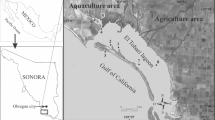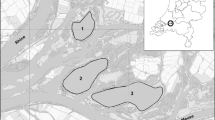Abstract
Boron (B), molybdenum (Mo), and selenium (Se) were measured in water, sediment, particulate organic detritus, and in various biota—filamentous algae, net plankton, macroinvertebrates, and fishes—to determine if concentrations were elevated from exposure to agricultural subsurface (tile) drainage during the spring and fall 1987, in the San Joaquin River, California. Concentrations of B and Se, but not Mo, were higher in most samples from reaches receiving tile drainage than in samples from reaches receiving no tile drainage. Maximum concentrations of Se in water (0.025 μg/mL), sediment (3.0 μg/g), invertebrates (14 μg/g), and fishes (17 μg/g) measured during this study exceeded concentrations that are detrimental to sensitive warmwater fishes. Toxic threshold concentrations of B and Mo in fishes and their foods have not been identified. Boron and Mo were not biomagnified in the aquatic food chain, because concentrations of these two elements were usually higher in filamentous algae and detritus than in invertebrates and fishes. Concentrations of Se were lower in filamentous algae than in invertebrates and fishes; however, concentrations of Se in or on detritus were similar to or higher than in invertebrates and fishes. These observations suggest that high concentrations of Se accumulated in invertebrates and fishes through food-chain transfer from Se-enriched detritus rather than from filamentous algae.
Similar content being viewed by others
References
Adams WJ, Johnson HE (1977) Survey of the selenium content in the aquatic biota of western Lake Erie. J Great Lakes Res 3:10–14
Baudo R (1983) Is analytically defined chemical speciation the answer we need to understand trace element transfer along a trophic chain? In: Leppard GG (ed) Trace element speciation in surface waters and its ecological implications. Plenum Press, NY, pp 275–290
— (1985) Transfer of trace elements along the aquatic food chain. Mem Ist Ital Idrobiol 43:281–309
Bennett WN, Brooks AS, Boraas ME (1986) Selenium uptake and transfer in an aquatic food chain and its effects on fathead minnow larvae. Arch Environ Contam Toxicol 15:513–517
Bertram PE, Brooks AS (1986) Kinetics of accumulation of selenium from food and water by fathead minnows. Water Res 20:877–884
Birge WJ, Black JA, Westerman AG, Hudson JE (1980) Aquatic toxicity tests on inorganic elements occurring in oil shale. In: Gale C (ed) Oil shale symposium: Sampling, analysis and quality assurance, EPA 600/9-80-022. US Environmental Protection Agency, Cincinnati, OH, pp 519–534
Boyd CE (1967) Some aspects of aquatic plant ecology. In: Reservoir fishery resources symposium, Southern Division, American Fisheries Society, Bethesda, MD, pp 114–129
Boyd CE, Walley WW (1972) Studies of the biogeochemistry of boron. I. Concentrations in surface waters, rainfall and aquatic plants. Am Midl Nat 88:1–14
Brooks AS (1984) Selenium in the environment, an old problem with new concerns. In: Workshop proceedings: The effects of trace elements on aquatic ecosystems. EPRI EA-3329, Project 1631, Electric Power Research Institute, Palo Alto, CA, pp 2.1–2.17
Brumbaugh WG, Walther MJ (1989) Determination of arsenic and selenium in whole fish by continuous-flow hydride generation atomic absorption spectrophotometry. J Assoc Offic Anal Chem 72:484–486
Burton GA Jr, Giddings TH, DeBrine P, Fall R (1987) High incidence of selenite-resistant bacteria from a site polluted with selenium. Appl Environ Microbiol 53:185–188
Chappell WR (1975) Transport and biological effects of molybdenum in the environment. In: Krenkel PA (ed) Heavy metals in the aquatic environment. Pergamon Press, NY, pp 167–188
Cherry DS, Guthrie RK (1977) Toxic metals in surface waters from coal ash. Water Resour Bull 13:1227–1236
Colborn T (1982) Measurement of low levels of molybdenum in the environment by using aquatic insects. Bull Environ Contam Toxicol 29:422–428
Conover WJ (1980) Practical nonparametric statistics, 2nd edition. John Wiley & Sons, NY, 493 pp
Deverel SJ, Gilliom RJ, Fujii R, Izbicki JA, and Fields JC (1984) Areal distribution of selenium and other inorganic constituents in shallow ground water of the San Luis Drain service area, San Joaquin Valley, California: A preliminary study. US Geological Survey, Water Resour Invest Rep 84-4319
Eisler R (1985) Selenium hazards to fish, wildlife, and invertebrates: a synoptic review. US Fish and Wildlife Service, Biol Rep 85(1.5), 57 pp
—(1989) Molybdenum hazards to fish, wildlife, and invertebrates: a synoptic review. US Fish and Wildlife Service, Biol Rep 85(1.19), 61 pp
—(1990) Boron hazards to fish, wildlife, and invertebrates: a synoptic review. US Fish and Wildlife Service, Biol Rep 85(1.20), 32 pp
Elwood JW, Hildebrand SG, Beuchamp JJ (1976) Contribution of gut contents to the concentration and body burden of elements inTipula spp. from a spring-fed stream. J Fish Res Board Can 33:1930–1938
Forstner U, Wittmann GTW (1979) Metal pollution in the aquatic environment. Springer-Verlag, NY, 486 pp
Goettl JP Jr, Davies PH (1977) Study of the effects of metallic ions on fish and aquatic organisms. Tissue molybdenum levels. In: Water pollution studies. Job Prog Rep, Fed Aid Proj F-33-R-12, Colorado Division of Wildlife, Fort Collins, CO, pp 53–61
Gough LP, Shacklette HT, Case AA (1979) Element concentrations toxic to plants, animals, and man. Geological Survey Bulletin 1466, U.S. Government Printing Office, Washington, DC, 80 pp
Hamilton SJ, Wiedmeyer RH (1990) Concentrations of boron, molybdenum, and selenium in chinook salmon. Trans Am Fish Soc 119:500–510
Hothem RL, Ohlendorf HM (1989) Contaminants in foods of aquatic birds at Kesterson Reservoir, California, 1985. Arch Environ Contam Toxicol 18:773–786
Jenkins DW (1980) Biological monitoring of toxic trace metals. Volume 2. Toxic trace metals in plants and animals of the world. Part I. US Environmental Protection Agency, EPA-600/3-80-090, Environmental Monitoring Systems Laboratory, Las Vegas, NV, 503 pp
Jones and Stokes Associates, Inc. (1985) Ecological and water management characterization of Grassland Water District. Prepared for the Grassland Water District, Los Banos, CA, by Jones and Stokes Associates, Inc, Sacramento, CA
Kay SH (1984) Potential for biomagnification of contaminants within marine and freshwater food webs. U.S. Army Corps of Engineers, Technical Report D-84-7, Washington, DC, 166 pp
Lemly AD (1985) Toxicology of selenium in a freshwater reservoir: Implications for environmental hazard evaluation and safety. Ecotoxicol Environ Safety 10:314–338
Lemly AD, Smith GJ (1987) Aquatic cycling of selenium: Implications for fish and wildlife. US Fish Wild Serv Leafl (12):1–10
Lynch TR, Popp CJ, Jacobi GZ (1988) Aquatic insects as environmental monitors of trace metal contamination: Red River, New Mexico. Water Air Soil Pollut 42:19–31
Moyle PB (1976) Inland fishes of California. University of California Press, Berkeley, CA, 405 pp
National Academy of Sciences (1976) Selenium. National Academy of Sciences, Publishing and Printing Office, Washington, DC, 203 pp
National Research Council (1983) Selenium in nutrition, rev ed. National Academy Press, Washington, DC, 174 pp
— (1989) Recommended dietary allowances, 10th ed. National Academy Press, Washington, DC, 284 pp
Ohlendorf HM, Hoffman DJ, Saiki MK, Aldrich TW (1986) Embryonic mortality and abnormalities of aquatic birds: Apparent impacts of selenium from irrigation drainwater. Sci Total Environ 52:49–63
Pennak RW (1978) Fresh-water invertebrates of the United States, 2nd ed. John Wiley & Sons, NY, 803 pp
Phillips GR, Russo RC (1978) Metal bioaccumulation in fishes and aquatic invertebrates: A literature review. US Environmental Protection Agency, EPA-600/3-78-103, Duluth, MN, 116 pp
Presser TS, Barnes I (1984) Selenium concentrations in waters tributary to and in the vicinity of the Kesterson National Wildlife Refuge, Fresno and Merced counties, California. US Geological Survey, Water Resour Invest Rep 84-4122
—,—(1985) Dissolved constituents including selenium in waters in the vicinity of Kesterson National Wildlife Refuge and the West Grassland, Fresno and Merced counties, California. US Geological Survey, Water Resour Invest Rep 85-4220
Rajaratnam JA, Lowry JB, Avadhani PN, Corley RHV (1971) Boron: possible role in plant metabolism. Science 172:1142–1143
Saiki MK (1984) Environmental conditions and fish faunas in low elevation rivers on the irrigated San Joaquin Valley floor, California. Calif Fish Game 70:145–157
— (1986) A field example of selenium contamination in a aquatic food chain. In: Proceedings of the First Annual Symposium on Selenium in the Environment, Fresno, CA, 10–12 June 1985. California Agricultural Technology Institute, Publ CATI/860201, Fresno, CA, pp 67–76
— (1989) Selenium and other trace elements in fish from the San Joaquin Valley and Suisun Bay, 1985. In: Selenium and Agricultural Drainage: Implications for San Francisco Bay and the Califomia Environment (Selenium IV). The Bay Institute of San Francisco, Sausalito, CA, pp 35–49
Saiki MK, Jennings MR, Hamilton SJ (1991) Preliminary assessment of the effects of selenium in agricultural drainage on fish in the San Joaquin Valley. In: Dinar A, Zilberman D (eds) The economics and management of water and drainage in agriculture. Kluwer Academic Publishers, Boston, MA, pp 369–385
Saiki MK, Jennings MR, Wiedmeyer RH (1992) Toxicity of agricultural subsurface drainwater from the San Joaquin Valley, California, to juvenile chinook salmon and striped bass. Trans Am Fish Soc 121:78–93
Saiki MK, Lowe TP (1987) Selenium in aquatic organisms from subsurface agricultural drainage water, San Joaquin Valley, California. Arch Environ Contain Toxicol 16:657–670
Saiki MK, May TW (1988) Trace element residues in bluegills and common carp from the lower San Joaquin River, California, and its tributaries. Sci Total Environ 74:199–217
Saiki MK, Palawski DU (1990) Selenium and other elements in juvenile striped bass from the San Joaquin Valley and San Francisco Estuary. Arch Environ Contam Toxicol 19:717–730
Saiki MK, Schmitt CJ (1985) Population biology of bluegills,Lepomis macrochirus, in lotic habitats on the irrigated San Joaquin Valley floor. Calif Fish Game 71:225–244
San Joaquin Valley Drainage Program (1989) Preliminary planning alternatives for solving agricultural drainage and drainge-related problems in the San Joaquin Valley. San Joaquin Valley Drainage Program, Sacramento, CA
—(1990) San Joaquin Valley Drainage Program; draft final report. Sacramento, CA
Schmitt CJ, Brumbaugh WG (1990) National Contaminant Biomonitoring Program: Concentrations of arsenic, cadmium, copper, lead, mercury, selenium, and zinc in U.S. freshwater fish, 1976–1984. Arch Environ Contam Toxicol 19:731–747
Schuler CA (1987) Impacts of agricultural drainwater and contaminants on wetlands at Kesterson Reservoir, California. MS Thesis, Oregon State University, Corvallis, OR, 136 pp
Schuler CA, Anthony RG, Ohlendorf HM (1990) Selenium in wetlands and waterfowl foods at Kesterson Reservoir, California, 1984. Arch Environ Contain Toxicol 19:845–853
Sprague RW (1972) The ecological significance of boron. US Borax Research Corporation, Anaheim, CA, 58 pp
State Water Resources Control Board (1987) Regulation of agricultural drainage to the San Joaquin River. SWRCB Order WQ 85-1, Technical Committee Report, Sacramento, CA
Swaine DJ (1955) The trace-element content of soils: Harpenden, England. Common Bur Soil Sci Technic Commun 48:91
Thompson JAJ, Davis JC, Drew RE (1976) Toxicity, uptake and survey studies of boron in the marine environment. Water Res 10:869–875
Thompson M, Pahlavanpour B, Thorne LT (1981) The simultaneous determination of arsenic, antimony, bismuth, selenium, and tellurium in waters by an inductively coupled plasma/volatile hydride method. Water Res 15:407–411
Underwood EJ (1977) Trace elements in human and animal nutrition, fourth edition. Academic Press, NY, 545 pp
US Environmental Protection Agency (1986) Quality criteria for water. EPA 440/5-86-001, Office of Water Regulations and Standards, Washington, DC
Ward JV (1973) Molybdenum concentrations in tissues of rainbow trout (Salmo gairdneri) and kokanee salmon (Oncorhynchus nerka) from waters differing widely in molybdenum content. J Fish Res Board Can 30:841–842
Webb JS, Thornton I, Fletcher K (1968) Geochemical reconnaissance and hypocuprosis. Nature (London) 217:1010–1012
Wetzel RG (1975) Limnology. W.B. Saunders Co, Philadelphia, PA, 743 pp
Windell JT, Bowen SH (1978) Methods for study of fish diets based on analysis of stomach contents. In: Bagenal T (ed) Methods for assessment of fish producton in fresh waters. IBP Handbook No 3, Blackwell Scientific Publications Ltd, Oxford, pp 219–226
Yamamoto T, Yamaoka T, Fujita T, Isoda C (1973) Boron content of marine plankton. Records of Oceanographic Works in Japan 12:13–21
Author information
Authors and Affiliations
Rights and permissions
About this article
Cite this article
Saiki, M.K., Jennings, M.R. & Brumbaugh, W.G. Boron, molybdenum, and selenium in aquatic food chains from the lower San Joaquin river and its tributaries, California. Arch. Environ. Contam. Toxicol. 24, 307–319 (1993). https://doi.org/10.1007/BF01128729
Received:
Accepted:
Issue Date:
DOI: https://doi.org/10.1007/BF01128729




